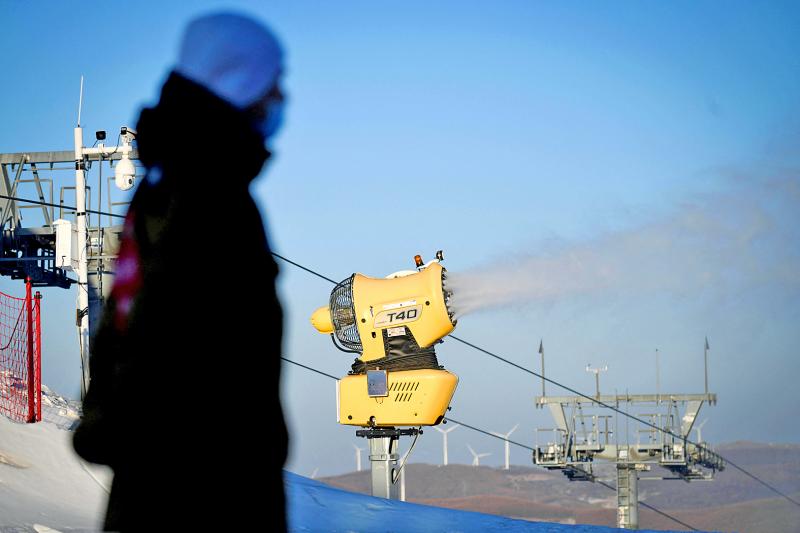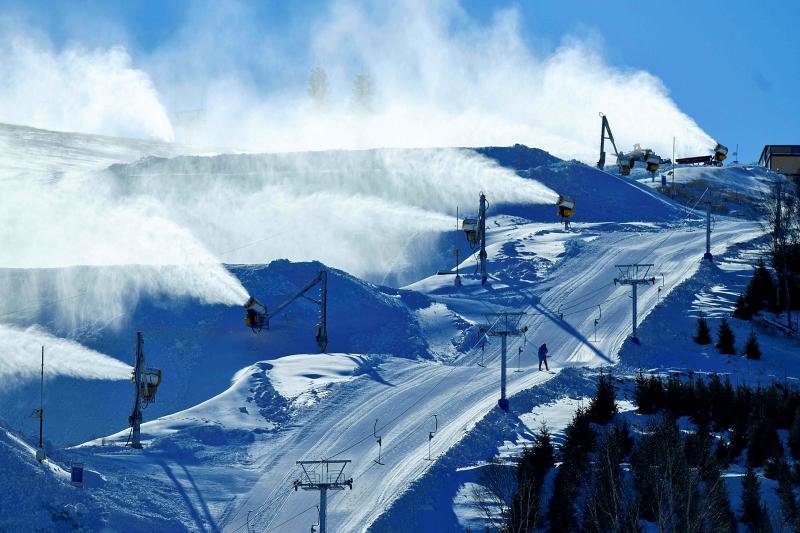Bright yellow turbines line the slopes of the Beijing Winter Olympics, spraying out the artificial snow needed for the Games to take place.
Man-made snow has been used to varying degrees since the 1980 Winter Olympics in Lake Placid, New York.
But February’s Beijing Games will depend almost entirely on artificial snow because they are happening in one of the driest parts of China.

Photo: AFP
With just five weeks until the Games begin, organizers are racing to coat the pistes in high-quality snow — a vast and complex task that critics say is environmentally unsustainable.
The venues use automated snow-making systems that monitor air temperature and humidity to maximize production.
Fed by local reservoirs, about 300 turbines — known as “snow guns” — mix water with compressed air before propelling the droplets into the air to form snow.

Photo: AFP
Workers then use truck-like vehicles called “snowcats” to spread the snow onto the pistes and sculpt jumps and turns.
Venues must ensure the snow meets precise standards of depth, hardness and consistency.
“The biggest challenge for us is maintaining uniform snow quality,” said Li Xin, deputy chief of mountain operations at the National Alpine Skiing Center in Yanqing (延慶), about 80km from Beijing.
Variations in the snow-making process “can cause snow quality to be too hard in some places and too soft in others, which could be dangerous for the athletes,” he told a press event at the site.
The stark white patches stand out vividly against Yanqing’s brown mountains, which see minimal natural snowfall. An International Olympic Committee evaluation report said that Zhangjiakou (張家口) and Yanqing — the Games zones hosting alpine skiing and snowboarding, among other outdoor events — “would rely completely on artificial snow.”
A 2020 study in science publication Nature warned that groundwater depletion in northern China was a “critical issue” and among the highest globally, due to intensive agricultural irrigation, rapid urbanization, and a dry climate.
This has meant water shortages for millions of Beijing residents and the water supply is likely to worsen in the future, researchers said.
Organizers at the Winter Olympics say the snow-makers are powered by renewable energy and will not damage mountain ecosystems, while the water they use will return to local reservoirs as the snow melts in spring.
The equipment’s automated systems reduce the kind of human error that can lead to wastage, said Florian Hajzeri, the China general manager for TechnoAlpin, the Italian company that supplies the machines.
With resorts worldwide turning to artificial snow to operate smoothly through the winter, “no matter which Olympics, there will always be snow-making systems for all of the venues,” he tsaid.
But experts say the reliance on man-made snow undermines Beijing’s pledge to hold a “green” Games.
Using large quantities of power and resources to create snow in the water-scarce region is “irresponsible”, said Carmen de Jong, a geography professor at France’s University of Strasbourg.
“We could just as well hold the Olympics on the moon or on Mars,” she said.

Most heroes are remembered for the battles they fought. Taiwan’s Black Bat Squadron is remembered for flying into Chinese airspace 838 times between 1953 and 1967, and for the 148 men whose sacrifice bought the intelligence that kept Taiwan secure. Two-thirds of the squadron died carrying out missions most people wouldn’t learn about for another 40 years. The squadron lost 15 aircraft and 148 crew members over those 14 years, making it the deadliest unit in Taiwan’s military history by casualty rate. They flew at night, often at low altitudes, straight into some of the most heavily defended airspace in Asia.

Many people in Taiwan first learned about universal basic income (UBI) — the idea that the government should provide regular, no-strings-attached payments to each citizen — in 2019. While seeking the Democratic nomination for the 2020 US presidential election, Andrew Yang, a politician of Taiwanese descent, said that, if elected, he’d institute a UBI of US$1,000 per month to “get the economic boot off of people’s throats, allowing them to lift their heads up, breathe, and get excited for the future.” His campaign petered out, but the concept of UBI hasn’t gone away. Throughout the industrialized world, there are fears that

Like much in the world today, theater has experienced major disruptions over the six years since COVID-19. The pandemic, the war in Ukraine and social media have created a new normal of geopolitical and information uncertainty, and the performing arts are not immune to these effects. “Ten years ago people wanted to come to the theater to engage with important issues, but now the Internet allows them to engage with those issues powerfully and immediately,” said Faith Tan, programming director of the Esplanade in Singapore, speaking last week in Japan. “One reaction to unpredictability has been a renewed emphasis on

Taiwan’s democracy is at risk. Be very alarmed. This is not a drill. The current constitutional crisis progressed slowly, then suddenly. Political tensions, partisan hostility and emotions are all running high right when cool heads and calm negotiation are most needed. Oxford defines brinkmanship as: “The art or practice of pursuing a dangerous policy to the limits of safety before stopping, especially in politics.” It says the term comes from a quote from a 1956 Cold War interview with then-American Secretary of State John Foster Dulles, when he said: ‘The ability to get to the verge without getting into the war is